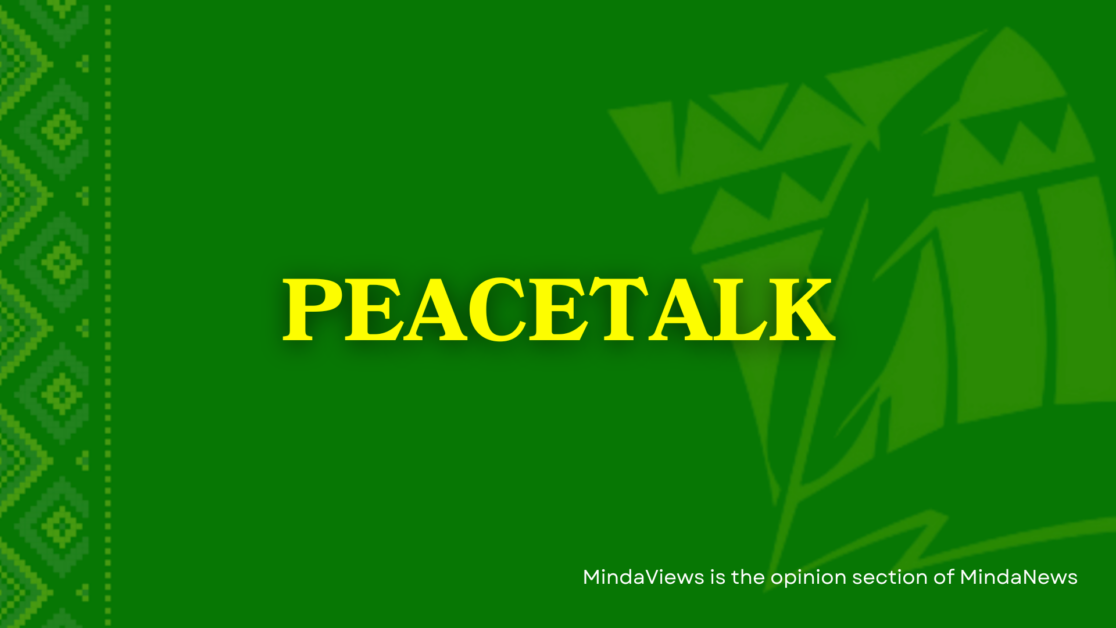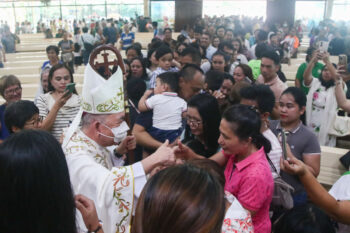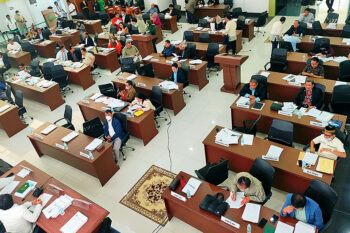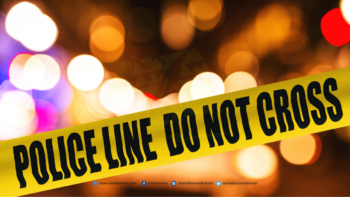
4th of 5 parts
NAGA CITY (MindaNews / 19 April) – Proclamation No. 404 granting amnesty to “former members” of the CPP-NPA-NDF or “their front organizations” does not define or name the latter. “Front organizations” may be defined as those created or infiltrated, but in any case controlled, by a mother organization to serve its purposes and interests. All four rebel groups subject of the four new amnesty Proclamations have their respective front organizations, but only Proclamation No. 404 makes reference to those of the C-N-N. Aside from the obvious widening of the net, as it were, whether positively or negatively, on the national democratic front (used here generically, as distinguished from the National Democratic Front), this may in a way be a left-handed (pun intended) compliment or acknowledgment of the important role of the front organizations of the C-N-N in its “struggle for national democracy,” as shown early on since the 1960s by the “historical role and contributions of Kabataang Makabayan,” according to no less than its Founding Chairman Jose Maria Sison on its 50th anniversary (1964) on November 30, 2014.
The National Democratic Front of the Philippines (NDFP, not just NDF) itself has named its member organizations, as follows, and so there is no doubt as to their being front organizations under the leading CPP-NPA tandem:
- Communist Party of the Philippines (CPP)
- New People’s Army (NPA)
- Moro Resistance and Liberation Organization (MRLO)
- Kabataang Makabayan (KM)
- Revolutionary Council of Trade Unions (RCTU)
- Pambansang Katipunan ng Mambubukid (PKM)
- Malayang Kilusan ng Bagong Kababaihan (MAKIBAKA)
- Christians for National Liberation (CNL)
- Katipunan ng Gurong Makabayan (KAGUMA)
- Makabayang Samahan Pangkalusugan (MASAPA)
- Liga ng Agham para sa Bayan (LAB)
- Lupon ng Manananggol para sa Bayan (LUMABAN)
- Artista at Manunulat para sa Sambayanan (ARMAS)
- Makabayang Kawaning Pilipino (MKP)
- Revolutionary Organization of Overseas Filipinos and their Families (COMPATRIOTS)
- Cordillera People’s Democratic Front (CPDF)
- Revolutionary Organization of Lumads (ROL)
- Katipunan ng mga Samahang Manggagawa (KASAMA)
In the related literature, after the CPP and NPA as the leading and most important organizations of the NDFP, the rest of the above-enumerated largely sectoral organizations are referred to as “underground mass organizations” (UGMOs). But these also have their corresponding aboveground, open and legal mass organizations referred to as “national democratic mass organizations” (NDMOs), in effect second-level front organizations of first-level front organizations. And here lies the rub, where it becomes tricky or sometimes bloody, both figuratively and literally, like when they are “Red-tagged.”
In this connection, there is the remarkable unappealed and therefore final Resolution dated 21 September 2022 by RTC Manila Branch 19 Judge Marlo A. Magdoza-Malagar in Civil Case No. R-MNL-18-00925-CV (Department of Justice vs. CPP and NPA) which dismissed the Petition to declare the CPP-NPA as terrorist groups under Section 17 of the RA 9372 or the Human Security Act of 2007, even as this was already repealed by RA 11479 or the Anti-Terrorism Act of 2020. In pp. 38-39 of this Resolution, there is a matrix based on the testimonies of prosecution witnesses Noel Minioto Legaspi and Joy James Alcoser Sanguino, both former cadres, not just ordinary members, of the C-N-N, “identifying the NDMOs targeting specific groups or sectors and their corresponding UGMOs as follows:”
| Sector | UGMO | NDMO |
| Youth andStudent | Kabataang Makabayan (KM) | – Anakbayan- League of Filipino Students (LFS)- National Union of Students of the Philippines (NUSP)- College Editors Guild of the Philippines (CEGP)- Student Christian Movement of the Philippines (SCMP) |
| Women | Malayang Kilusan ng Bagong Kababaihan (MAKIBAKA) | – Gabriela Youth- Gabriela Women’s Party |
| Farmers, Fisherfolks and Peasants | Pambansang Katipunan ng Magbubukid (PKM) | – Kilusang Magbubukid ng Pilipinas (KMP)- Unyon ng Magsasaka sa Agrikultura (UMA)- Pambansang Lakas ng mga Mamamalakaya (PAMALAKAYA) |
| Workers | Revolutionary Council of Trade Unions (RCTU) | – Kilusang Mayo Uno (KMU) |
| Urban Poor | Katipunan ng mga Samahang Manggagawa (KASAMA) | – Katipunan na Damayang Mahihirap (KADAMAY) |
| Transport | Pambansang Samahan ng mga Makabayang Tsuper (PSMT) | – Pinagkaisang Samahan ng mga Tsuper at Opereytor Nationwide (PISTON) |
| Teachers | Katipunan ng mga Gurong Makabayan (KAGUMA) | – Alliance of Concerned Teachers (ACT)- Congress of Teachers and Educators for Nationalism and Democracy (CONTEND) |
| Government | Makabayang Kawaning Pilipino (MKP) | Confederation for Unity and Advancement of Government Employees (COURAGE) |
| Health | Makabayang Samahang Pangkalusugan (MASAPA) | – Alliance of Health Workers (AHW)- Health Alliance for Democracy (HEAD) |
| Lawyers | Lupon ng Manananggol para sa Bayan (LUMABAN) | – National Union of People’s Lawyers (NUPL) |
| Scientists | Liga ng Agham para sa Bayan (LAB) | AGHAM |
| Church | Christians for National Liberation (CNL) | – Promotion of Church Peoples’ Response (PCPR) |
| Artists | Artista at Manunulat ng Sambayanan (ARMAS) | – National Union of Journalists in the Philippines (NUJP)- Concerned Artists of the PhilippinesMusika Alay sa Bayan |
The above listing of NDMOs does not appear to be exhaustive or complete, in terms of sectors and organizations, and any such listing is bound to be contested. But note that this above NDMOs list is taken from no less than a court Resolution that is deemed by the Civil Code as “form[ing] a part of the legal system of the Philippines.” Would its above-quoted matrix be considered as “Red-tagging”? Or if a similar matrix would be presented in an academic journal article based on post-graduate academic research in political science, would it be considered as “Red-tagging”? Or if a similar matrix would be presented in a newspaper or magazine based on investigative journalism, would it be considered as “Red-tagging”? OR what if the NAC through its expected IRR or some other guidelines were to list NDMOs (there should be no question with UGMOs) as “front organizations” of the C-N-N, for purposes of implementing Proclamation No. 404, would it be considered as “Red-tagging”? Just asking, while realizing that the whole issue of “Red-tagging” is best treated separately from the herein amnesty topic.
Tomorrow: The Case of “Political Detainees and Prisoners”
(SOLIMAN M. SANTOS JR. is a retired RTC Judge of Naga City, Camarines Sur, serving in the judiciary there from 2010 to 2022. He has an A.B. in History cum laude from U.P. in 1975, a Bachelor of Laws from the University of Nueva Caceres (UNC) in Naga City in 1982, and a Master of Laws from the University of Melbourne in 2000. He is a long-time human rights and international humanitarian lawyer; legislative consultant and legal scholar; peace advocate, researcher and writer; and author of a number of books, including on the Moro and Communist fronts of war and peace. Among his authored books are The Moro Islamic Challenge: Constitutional Rethinking for the Mindanao Peace Process published by UP Press in 2001; Judicial Activist: The Work of a Judge in the RTC of Naga City published by Central Books in 2023; and his latest, Tigaon 1969: Untold Stories of the CPP-NPA, KM and SDK published by Ateneo Press in 2023.)







